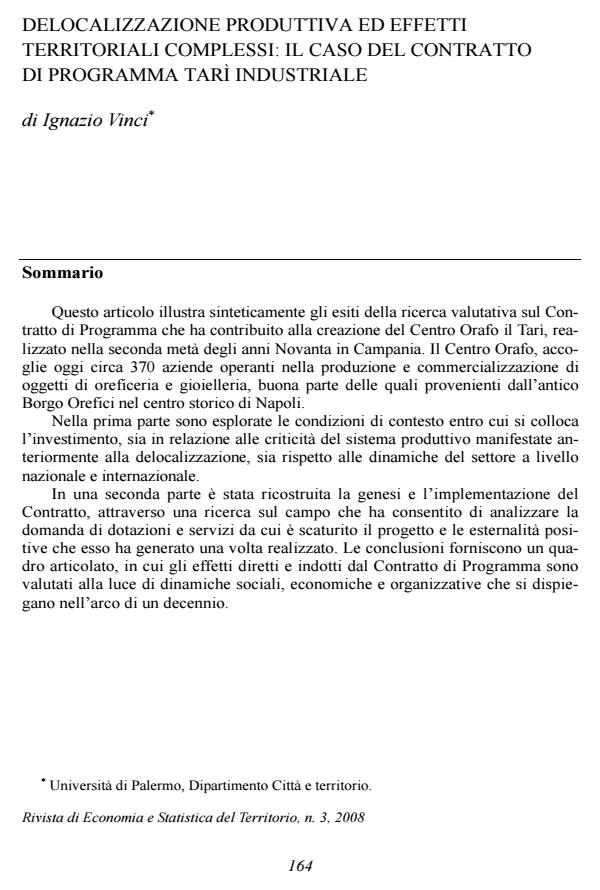Delocalizzazione produttiva ad effetti territoriali complessi: il caso del Contratto di Programma Tarì Industriale
Journal title RIVISTA DI ECONOMIA E STATISTICA DEL TERRITORIO
Author/s Ignazio Vinci
Publishing Year 2009 Issue 2008/3
Language Italian Pages 21 P. 164-184 File size 119 KB
DOI
DOI is like a bar code for intellectual property: to have more infomation
click here
Below, you can see the article first page
If you want to buy this article in PDF format, you can do it, following the instructions to buy download credits

FrancoAngeli is member of Publishers International Linking Association, Inc (PILA), a not-for-profit association which run the CrossRef service enabling links to and from online scholarly content.
Territorial Innovation through Productive Delocalization: the Case of the Contratto di Programma Tarì Industriale in Campania - Objectives This article is a synthetic report of a one-year research aimed at evaluating the effectiveness of the CdP signed by "Tarì Industriale", a consortium of small firms operating in the sector of jewellery in Campania. The consortium have joined about 50 enterprises which were previously located in Borgo Orefici, an old discrict in the historic centre of Naples. The CdP is a tool for the promotion of industrial development in Southern regions adopted by the Italian government in 1986, aiming at coordinating productive investments with technological innovation and employment development policies. The CdP "Tarì Industriale" outcome is the Centro Orafo "Il Tarì" in Marcianise, a new business district holding more than 370 firms in the jewellery sector. Methods and Results The overall objectives of the research were evaluating the role of the CdP in influencing the firms’ decisions and assessing the direct and indirect impact of the investment towards the economic sector at local and regional level. According to these purposes, the research have been carried out through different analytical approaches. First, the analysis of statistical sources brought to consider the dynamics of the economic sector, whose trends have strongly affected the performance of the local firms during the last decades. Secondly, with the contribution of the (former and present) management of the consortium, it has been analysed the process of implementation of the CdP. This phase provided an interesting cross-section of the local milieu before the investment and helped to comprehend the reasons that brought the entrepreneurs of Borgo Orefici to start the new industrial project. Interviews were also carried out with severel members of the consortium, in order to evaluate the satisfaction with the planning initiative and the impact of the new business district on their economic performances. Conclusions The research provided interesting evidences both from the economic and the policy- making point of views. On the one hand, it has been demonstrated that the CdP may not be considered the only spur for the delocalization process. The raise of environmental and crimes problems in Borgo Orefici would have led the most dynamic firms to relocate their business all the same. An other critical result is the poor contribution of the CdP in stimulating research activities and technological innovation. On the other, it is largely recognized that, in the absence of the CdP, the new business district would have been planned in a less sophisticated way. This regards particularly the providing of services for commercial activities (such as marketing and event management) and the implementation of a training programme.
Ignazio Vinci, Delocalizzazione produttiva ad effetti territoriali complessi: il caso del Contratto di Programma Tarì Industriale in "RIVISTA DI ECONOMIA E STATISTICA DEL TERRITORIO" 3/2008, pp 164-184, DOI: